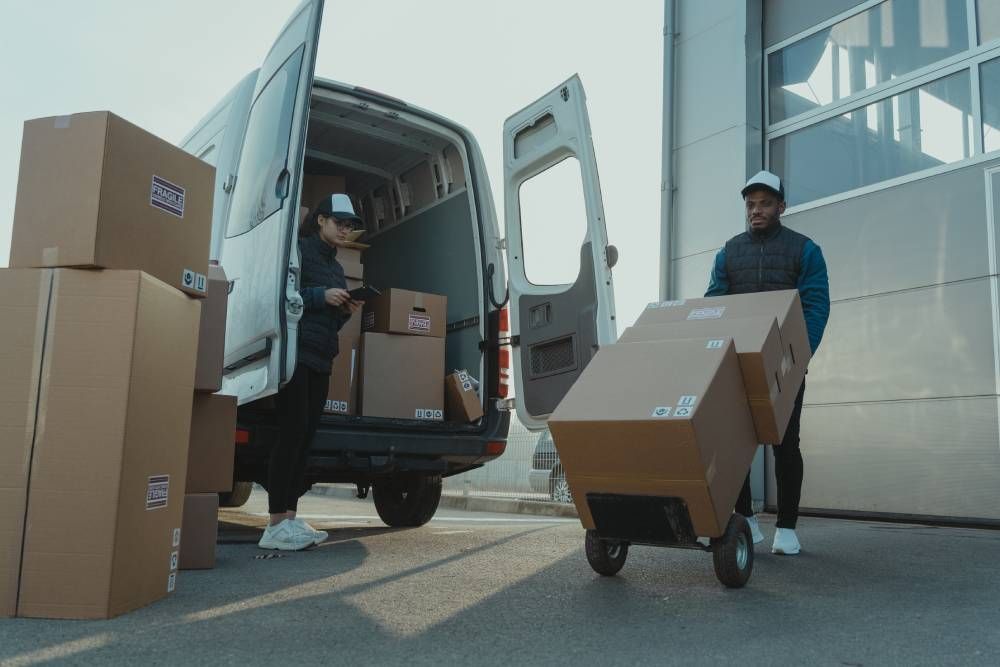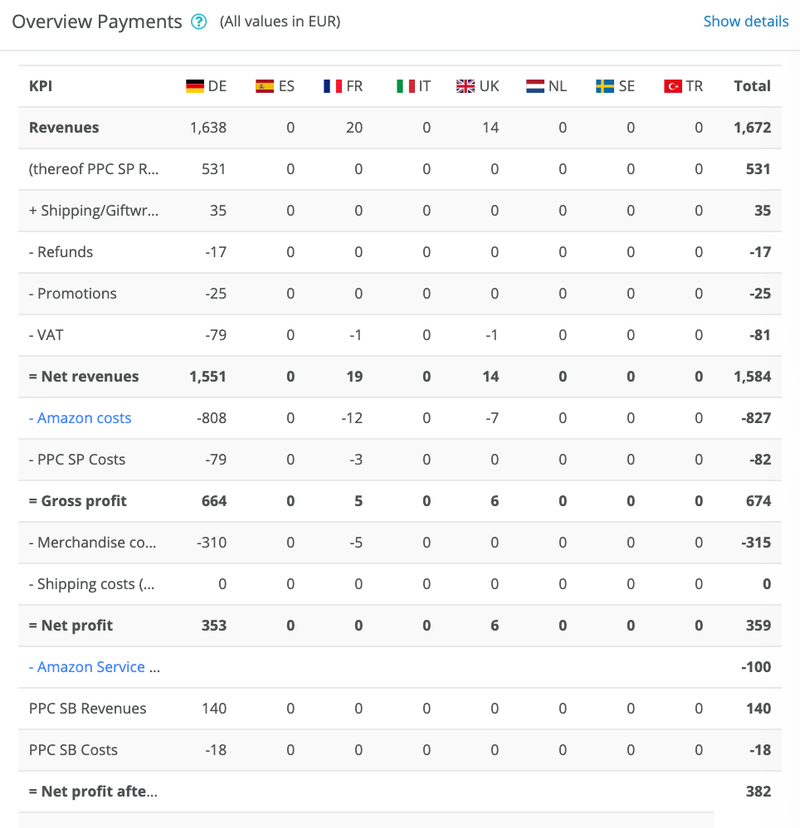- What is the Amazon Frustration-Free Packaging program?
- Chargeback payments with the reason "Ships in Own Container (SIOC) / Frustration-Free Packaging (FFP)"
- How do I certify packages for the Amazon SIOC and FFP programs?
- As a customer, how can I tell if my package is certified?
- Conclusion
Amazon packs products for shipment to customers in own boxes. For years, Amazon wants to reduce this step and therefore Amazon launched the frustration-free packaging program in 2008. The frustration-free packaging program includes PFP, SIOC, and FFP certification. Ideally, the vendor provides Amazon with packaging that offers adequate protection, eliminating the need for an Amazon outer carton and requiring only a label to be applied before the product is shipped to the customer.
To ensure that the cartons are suitable for shipping, tests are conducted for verification. The tests will replicate a typical shipping process from truck transport to delivery by the mail carrier. To verify that the product packaging provides adequate protection, the test involves dropping the package from different heights, pressing it between two boxes, and shaking it. The tests are conducted either by an Amazon lab, by a third-party certification lab, or by Amazon Vendors themselves. If the product packaging passes the inspection, you receive the appropriate certification.
The Amazon FFP (Frustration Free Packaging) program divides all packaging into three certification levels:
- Level 1: Frustration-Free Packaging (FFP)
- Level 2: Ships in Own Container (SIOC)
- Level 3: Prep-Free Packaging (PFP)
In this article, we explain the differences between the three certification levels. In addition, we explain how to certify your products and what testing options are available.
What is the Amazon Frustration-Free Packaging program?
The Amazon certification program is divided into three levels:
- Level 1 - Frustration-Free Packaging (FFP).
- Level 2 - Ships in Own Container (SIOC)
- Level 3 - Prep-Free Packaging (PFP)
The individual levels are also often referred to by Amazon as Tier 1, Tier 2, Tier 3. Tier 1 is the highest and therefore best Tier Vendors can achieve.
A certified frustration-free packaging must protect the product from damaging the entire delivery route to the customer's doorstep. At FFP and SIOC certification, no more packaging or preparation is required from Amazon. At level 3, no more preparation is required from Amazon - i.e. Amazon no longer has to secure the item separately - but an outer carton is still required. This is not required at levels 1 and 2. Packages can be shipped to the customer immediately upon arrival at Amazon.
Prep-Free Packaging (PFP)
The "Amazon Prep-Free Packaging (PFP)" program applies to items that cannot be shipped to the customer in their original packaging due to their small size. Under the Prep-Free Packaging program, Vendors secure products in their own boxes suitable for shipping. The packages are properly secured for shipping and no preparations need to be made by Amazon to secure the contents (Prep-Free). Once the package arrives at Amazon, it is packed in a cardboard box before being sent to the customer.
Ships in Own Container (SIOC)
"Ships in Own Container" is another concept in Amazon's packaging certification program. In the SIOC program, also called the ECR (e-Commerce ready Packaging) program, Vendors design their packaging suitable for e-commerce that is shipped directly to the customer. Once the packages arrive at Amazon, Amazon does not have to do any additional work. The packages are not repackaged or otherwise processed. They are shipped to the customer just as they arrived at Amazon.
Chargeback payment due to non-certified ASIN?
Note that if your products are larger than 45.4 cm x 34.0 cm x 26.5 cm and heavier than 12.3 kg, SIOC or FFP certification is mandatory as of October 1, 2019. If you do not have the affected products certified, Amazon will charge a chargeback payment of 1.70€ per non-certified ASIN
Requirements for "Ships in Own Container" certification:
- the packaging protects the product from damage: the product must be secured by the vendor-created packaging, so Amazon does not have to wrap the package in an outer carton
- Minimum dimensions: for you to certify a product for the SIOC program, the product must be at least 20.32 cm x 11.99 cm x 0.95 cm in size
Advantages of "Ships in Own Container" certification:
- since Amazon does not have to pack the packages in an additional outer box, less packaging is needed
- the SIOC certification confirms that the packages are sufficiently secured for transport. Therefore, the packages can be transported without any special measures, which saves you transport costs
- during the tests, a typical shipping process is simulated. If the package passes the test, it will arrive safely at the customer's premises. If customers always receive their products undamaged, customer satisfaction increases
- They do not have to produce expensive display packaging. In retail, customers are additionally convinced by product packaging. In online stores, however, packaging does not influence the purchase decision. Furthermore, you don't have to take any measures to protect against theft, because the products are not shipped until the customer has paid for the product
Frustration-Free Packaging (FFP)
Amazon "Frustration-Free Packaging" is the highest level of Amazon's packaging certification program. It goes even further than the SIOC program. Sellers' goods are shipped to customers in their packaging, as with the SIOC program, but in addition, the packaging receives FFP certification. The certification means that the packages are particularly easy to open, produce as little waste as possible, are made of reusable packaging materials, and still protect the product from damage in the best possible way. Products with FFP certification meet all guidelines for the SIOC program and must also meet additional requirements.
Requirements for "Frustration-Free Packaging" certification:
As with the SIOC program, certain minimum dimensions must be met. To certify a product for the FFP program, the product must be at least 20.32 cm x 11.99 cm x 0.95 cm.
Frustration-free packaging is easy and quick to open. The packaging must be easy to open by the customer with minimal use of scissors or cutters. Likewise, the package must not contain plastic inserts, filler chips, paper shreds, or similar. It must be possible to remove the package contents within 120 seconds.
The packaging creates as little waste as possible. Amazon gives you minimum product to packaging ratio requirements to keep the volume of packaging to a minimum. The ratio is called the "Box Utilization Score" and is calculated by dividing the volume of the packaging by the total volume of the packaging. Here is a simple example:
| Length | Width | Height | Total volume | |
|---|---|---|---|---|
| Product dimensions | 50 cm | 20 cm | 15 cm | 50 cm x 20 cm x 15 cm = 13.000 cm³ |
| Packaging dimensions | 50 cm | 25 cm | 20 cm | 50 cm x 25 cm x 20 cm =25.000 cm³ |
To calculate the so-called "Box Utilization Score", divide the total volume 15,000 by 25,000 and obtain the result 0.6, i.e. 60 percent. The "Box Utilization Score" describes what percentage of the box contents are utilized. The score must be greater than 30 percent for a delicate, fragile product and greater than 50 percent for an insensitive product.
Packaging protects the product from damage. A frustration-free package must be six-sided and rectangular so that it stacks well in a trailer. Also, the package must be flat and have no bulges, viewing windows, or cutouts. Handle cutouts are allowed, but must not be larger than 7.6 cm x 3.8 cm. All open corners and edges must be completely sealed so that the package is not damaged either at the logistics center or on its way to the customer.
A frustration-free package consists of reusable packaging material. The packaging is made entirely of reusable materials, such as corrugated cardboard or other paper-based materials. In addition, any printing or processing shall not affect the recyclability of the packaging. Be careful with plastic films or plastic bags. These are only permitted if the product consists of small parts or the film is used for dust protection. Binding wires may only be used to organize cables. They may not be used to secure the item to the packaging
Benefits of Frustration-Free Packaging Certification:
In addition to the benefits of the SIOC certification, Frustration-Free Packaging certification features the following benefits:
- since the packaging is fully made of recyclable packaging materials, the packaging is environmentally friendly. Reusable packaging may convince the customer to buy the product
- by complying with the "Box Utilization Score", the package is the exact size. This means that the customer has to remove less packaging waste after the purchase
- customer satisfaction also increases because the packages are particularly easy and quick to open
Chargeback payments with the reason "Ships in Own Container (SIOC) / Frustration-Free Packaging (FFP)"
Amazon chargeback payments arise for a variety of reasons. Read our article on Amazon chargeback payments for a complete overview.
If you ship products that are larger than 35.5 cm x 34.0 cm x 26.5 cm or heavier than 12.3 kg, certification for the "Frustration-Free Packaging" or "Ships in Own Container" program is mandatory as of October 1, 2019. If your products are not yet certified accordingly, Amazon will charge a compensation payment of 1.70 euros per ASIN.
Even if the justification is "Ships in Own Container / Frustration-Free Packaging", it is sufficient if you have your products certified for the SIOC program. You can additionally apply for the FFP certification, but you do not have to.
For the following products exceptions apply. These are not required to be certified for the SIOC or FFP program:
- ASINs classified as Hazmat: Hazmat is the abbreviation for "Hazardous Material". Products with lithium-ion batteries, for example, fall under this classification
- ASINs of the product categories Fresh or Media: the product categories are food orders
- ASINs that are at least eight months old (i.e. ASINs that were created on Amazon more than eight months ago) and of which less than 700 items have been shipped to Amazon in the past twelve months
- an exception is possible if items are sent to Amazon, but are subsequently shipped to the customer with other items. Amazon packs the individual items in a package to make the best use of the available freight space. If you would like to request the exception, click "Contact Us" under "Support" in Vendor Central. You select the affected product category and then click on "Amazon Packaging Certification". From there, explain your claim and include a figure of the freight packaging
- Products that are long and thin: for you to certify a product for the SIOC or FFP program, the product packaging must be at least 20.32 cm x 11.99 cm x 0.95 cm. However, packaged items where the longest side is shorter than 20.32 cm or the shortest side is shorter than 0.95 cm or the middle side is shorter than 11.99 cm fall under the exemption and do not have to be certified mandatorily
Products that meet the weight and size requirements and do not fall under the exemptions must be certified as a Level 1 (FFP) or Level 2 (SIOC) product according to Amazon's frustration-free packaging program.
How do I certify packages for the Amazon SIOC and FFP programs?
There are three possible options for certifying products: You perform a Vendor drop test to test and register non-fragile ASINs weighing less than 23 kg by yourself. You can also send your fragile products that weigh more than 23 kg to the Amazon Packaging Lab. Another alternative is the ISTA-certified third-party testing labs for testing and registering fragile and non-fragile ASINs regardless of weight.
During certification, shipping packages must pass various tests. The tests simulate possible situations in the shipping process to verify that the packaging and the product can withstand common shipping conditions.
Vendors drop test to enroll non-fragile ASINs under 23 kg
Effective June 1, 2021, Vendors can perform a self-test, to be more specific a drop test, on non-fragile ASINs under 23 kg to certify ASINs for the FFP or SIOC program.
To perform the self-test, you will need the following tools: a chair, a marking pen, a tape measure, a craft knife, a camera or cell phone, a computer, a wall or similar to measure drop heights, and a solid sub-surface/floor. Amazon recommends wearing sneakers, safety gloves, and safety glasses during testing.
Before you can start the drop test, you need to number your package. Place your package on the floor with the largest face down and measure the package with the tape measure. To number, stand in front of the package so that the smallest face of the package is facing you. Start with the large surface and label it 1. Turn the package to the right and label the medium-sized surface number 2. The other large surface is number 3, the other medium-sized surface is number 4. The two small surfaces are numbers 5 and 6. See the drop test evaluation form for an example of numbering. If you are testing a padded shipping bag, number it as if it had six faces.
Before you perform the drop tests, you must take two pre-test pictures of your numbered package. The first photo shows faces 1, 2, and 5, and the second photo shows faces 3, 4, and 6.
Now you can start performing the test. Decide on a wall where you can measure the drop height. Amazon gives two drop heights: 45.72 cm and 91.44 cm (the drop heights are given on the test form in 18 inches and 36 inches) and how the item should fall to the floor. The package must fall on each corner, edge, and face.
Once the drop test is complete, inspect the carton for damage. Pushed-in corners and edges are not a problem, however, the product should never pierce the carton. Next, open the carton to verify that the product survived the drop. Search the item for dents, tears, etc., and verify that the product is still functioning properly.
If you think your ASIN passed the test, take four more photos for the evaluation form. The first photo shows the entire contents of the box. The next photo shows a product photographed close up. For the last two photos, you can show whatever you want of the package or contents.
Finally, fill out the Amazon Drop Test Evaluation (Amazon Drop Test Evaluation) form. This can be found at this link and here you can see an example of a completed form. To fill it out you will need the vendor name, ASN number, item description, package dimensions, and package weight. The ASN (Advanced Shipment Notification) is a digital notification where you list the contents of the shipment. For certification, you can choose between "Frustrated packaging" and "Shipment in original packaging". For sealing the package, you have a choice between tape and adhesive. In the last section, you insert the photos in the appropriate fields.
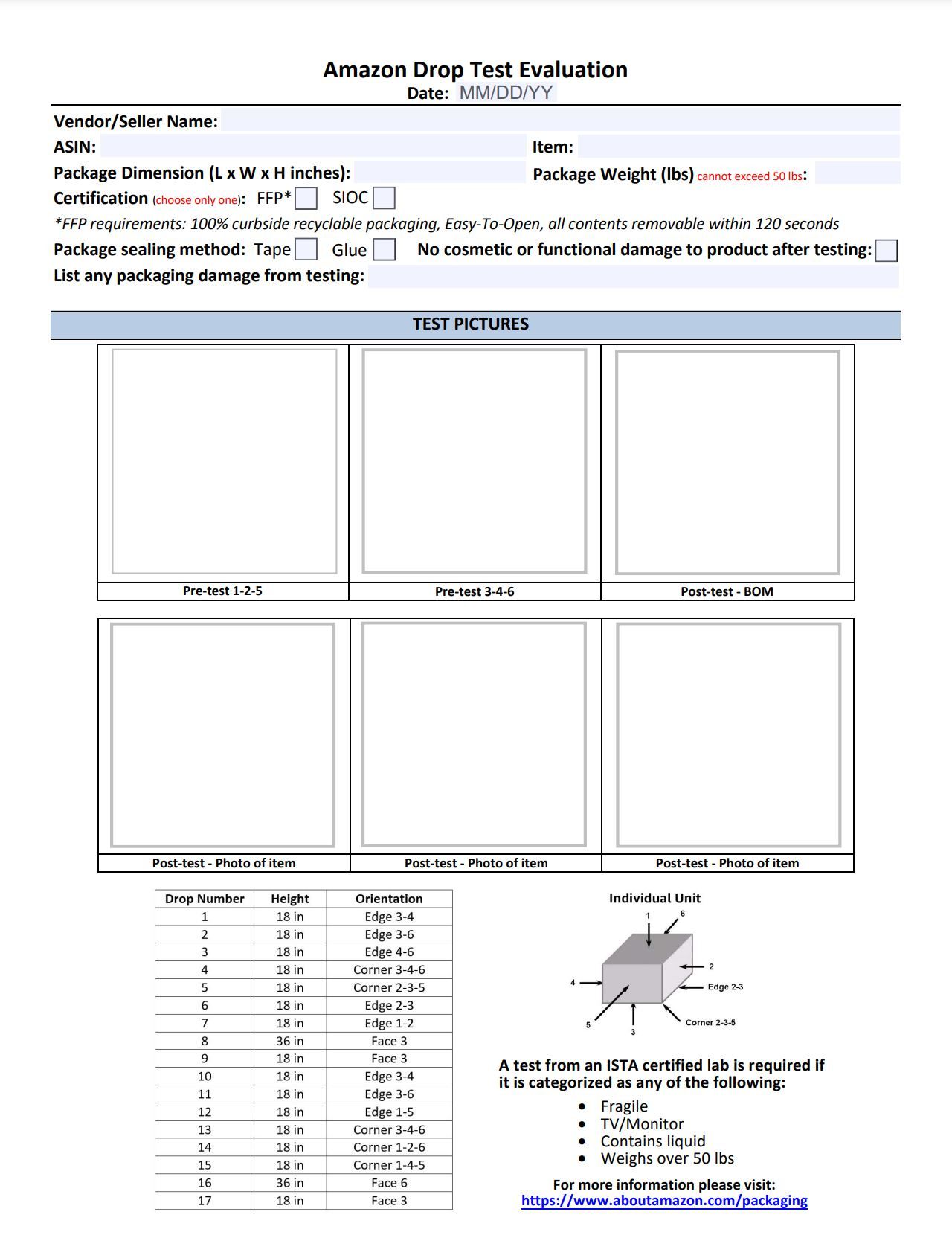
Submit the Amazon Drop Test Evaluation along with the Amazon Vendor enrollment template in Vendor Central for certification. The Vendor Registration Form can be found here →. We explain how to complete the registration form under "3.3 ISTA Certified Third Party Packaging Laboratories". Go to "Contact Us" in Vendor Central under "Support". You will select the affected product category and then click on "Amazon Packaging Certification". Select "Enroll and certify ASINs" and add the drop test evaluation form and Vendor enrollment template in the attachment.
The self-test meets the requirements of the so-called ISTA-6-Amazon.com-SIOC test. Note that you can only register one primary ASIN per submitted contact form.
Amazon Packaging Lab / Standard Operating Procedure (SOP) for testing and registering fragile ASINs under 23 kg
Fragile items cannot be certified by Vendors through self-testing. As of September 2021, as an alternative to third-party testing, Amazon offers Vendors to send their product packaging to the Amazon Packaging Lab for testing and certification.
Fragile items are any items that may leak or break during the logistics process. This includes the following materials: glass, ceramic, porcelain, or clay. Liquids, semi-liquids, or substances that liquefy at over 21 degrees Celsius are also counted as fragile items. If a product consists of at least 50 percent fragile material, it is classified as fragile.
To have a primary ASIN tested and enrolled in the Amazon Packaging Lab, you must first complete the Vendor enrollment template. In this form, you tell Amazon which ASIN you want to be tested and certified. The Vendor enrollment form can be found here →. By clicking on "Vendor enrollment template (Amazon Packaging Lab)", you will download the Excel file. Amazon provides an example of what the completed form may look like:

Under "Preferred Website Language" you select the preferred website language. If you select "DE", the help pages behind the "Click Here" links will be displayed in German.
- Column A: the "ASIN to Certify" is a 10-digit alphanumeric number that Amazon uses to identify the product to be certified
- Column B: the "Vendor Code" is usually 32 characters. You will find this on the order of the product to be registered
- Column C: under "Region" you can choose between "EU" (European Union) and "NA" (North America). If you sell your product on both marketplaces, then select "Both"
- Column D: here you have a dropdown menu again. In the first row, you need to select "Primary ASIN". The primary ASIN is the item you are sending to the packaging lab for testing. There can only be one primary ASIN per registration. For all other lines, you have the options "Same Primary ASIN - Alternative Vendor Code" (this is a product with the same ASIN but not yet certified), "Secondary ASIN - Color, Flavor, Scent, or Formula Variation" (the product differs from the primary ASIN only in terms of color, flavor, scent, or formula), and "Secondary ASIN - Form-Factor Variation" (the product differs from the primary ASIN only in terms of packaging). The options indicate how the secondary ASINs relate to the primary ASIN. If you are unsure which option to select, view the Help Video from Amazon. This document explains the certification rules for secondary ASINS
- Column E: Here you specify the type of certification you are requesting. You choose between FFP, SIOC, and PFP
- Column F: enter the name of the shipping service provider you are using to send the product samples to the Amazon packaging lab
- Column G: enter the shipment tracking number
- Column H: enter the number of samples you are sending to the packaging lab.
- Column I: in the "Future Certification Date" column, Vendors can tell Amazon the earliest date that their new packaging certification, if approved by Amazon, should be effective. This allows Vendors to tell Amazon when they expect their inventory to be ready for shipment with the new packaging in the Amazon logistics center. If you leave this field blank, the date of certification by Amazon will be automatically inserted
You will then need to send the required number of product samples for the primary ASIN to the Amazon packaging lab. Normally, you will need to send five samples to Amazon for fragile products, but there are special rules, e.g. for monitors only one sample is required. In the Excel file from step 1, you will find the packing list in another tab. Once you have finished filling out the registration form, the packing list will be automatically filled out with the information you provided. Print the packing list and enclose it with the shipment.

Email the Vendor enrollment template to the following address: cpex-test-enroll-na@amazon.com. Include the ASIN to be certified in the subject of the email. Send the five product samples to the Amazon Packaging Lab. The exact address is 1800 140th Ave. East, Attn. Amazon Packaging Lab, Sumner, WA 98390.
Note that you must complete a separate enrollment template for each primary ASIN you send to Amazon's packaging lab and submit it in a separate email.
Note
You can use Amazon packaging lab to test fragile ASINs under 23kg. However, this is not a requirement, you can also have this done by another ISTA 6 certified lab. In contrast to the third-party tests, the test in the Amazon Packaging Lab is currently free of charge.
ISTA-certified third-party packaging test labs
ISTA-certified packaging testing labs test, design, and certify your product packaging as FFP, SIOC, or PFP without additional testing or documentation from Amazon. The labs test your products according to the ISTA 6-Amazon.com or ISTA 6-Amazon.com over-the-carton method testing regulations. If your products pass the certification, the lab will provide you with an Amazon standard lab report that you upload to Amazon.
On the ISTA Website you will find a list of the APASS Network (Amazon Packaging and Supplier Network). With the APASS Network, Amazon provides Vendors with companies and labs to help you certify your products. To find a lab, click on "Find a lab" on the ISTA website. If you are searching for a specific lab, type in the name. If you press "Search" directly, all third-party testing labs worldwide will be displayed on the map. Alternatively, this PDF document provides a list of companies and labs that can help test, design, and supply packaging in line with meeting Amazon's Packaging Certifications.
On the third-party websites, you will read about Type A, B, C, etc. certifications. Which certification you need depends on the size and weight of the box:
| Weight requirements | and / or | Dimensions requirements | Test procedure | Number of examinations | |
|---|---|---|---|---|---|
| Standard | < 23 kg | and | > 152,4 x 101,6 x 9,5 mm | ISTA 6-Amazon.com (SIOC) Type A or drop test | Fragile: 5, non-fragile: 1 |
| Oversize | > 23 kg | or | all dimensions > 274 cm | ISTA 6-Amazon.com (SIOC) Type B – Type F | Fragile: 5, non-fragile: 1 |
| TVs | < 68 kg | and | < 419 cm scope* | ISTA 6-Amazon.com (SIOC) Type G | 1 |
| TVs | > 68 kg | or | > 419 cm scope | ISTA 6-Amazon.com (SIOC) Type H | 1 |
| Level 3 | < 23 kg | and | < 152,4 x 101,6 x 9,5 mm | ISTA 6-Amazon.com shipping package | Fragile: 5, non-fragile: 2 |
*the scope is calculated by adding length + 2 x height + 2 x width
However, you don't have to determine the exact type. If you provide the third-party lab with the product and the dimensions and weight of the package, they can tell you exactly which test to perform.
In the lab, similar to the other tests, the shipping process is also simulated. The packages are dropped from different heights and shaken through. That's why you don't send packages to a lab until you're sure the items will survive the tests. Third-party testing costs between 1,000 euro and 1,600 euro but depends on the ASIN being tested. Testing a non-fragile product, for example, is less expensive than testing a fragile product.
After testing is complete, Vendors must certify product packaging in Vendor Central:
- Log in to Vendor Central and click on "Support". Scroll to the bottom of the page. There you will find the "Contact Us" button.
- choose a product category, e.g. Beauty, Electronics, etc.
- then click on "Amazon Packaging Certification". You can choose from three options: 1. "Enroll and Certify ASINs", 2. "Other Packaging Certification Questions" and 3. "Portfolio Certification Status Update".
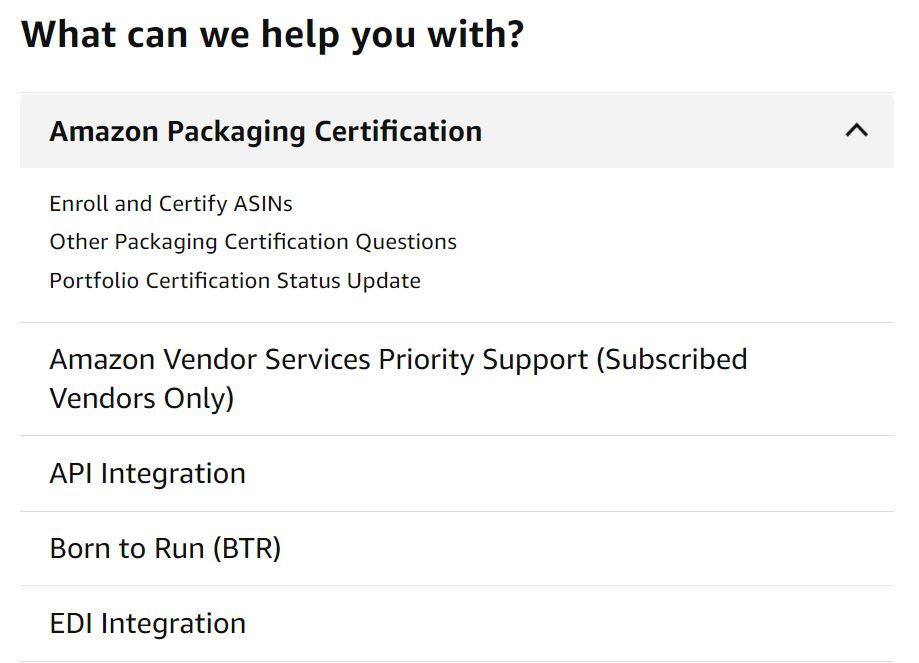
- Click on "Enroll and Certify ASIN". You will be prompted to include both the completed ISTA6 Packaging Test Report (you will receive this from the external test lab) and a completed Vendor Enrollment Template. Vendors are only allowed to register one ASIN per submitted contact form
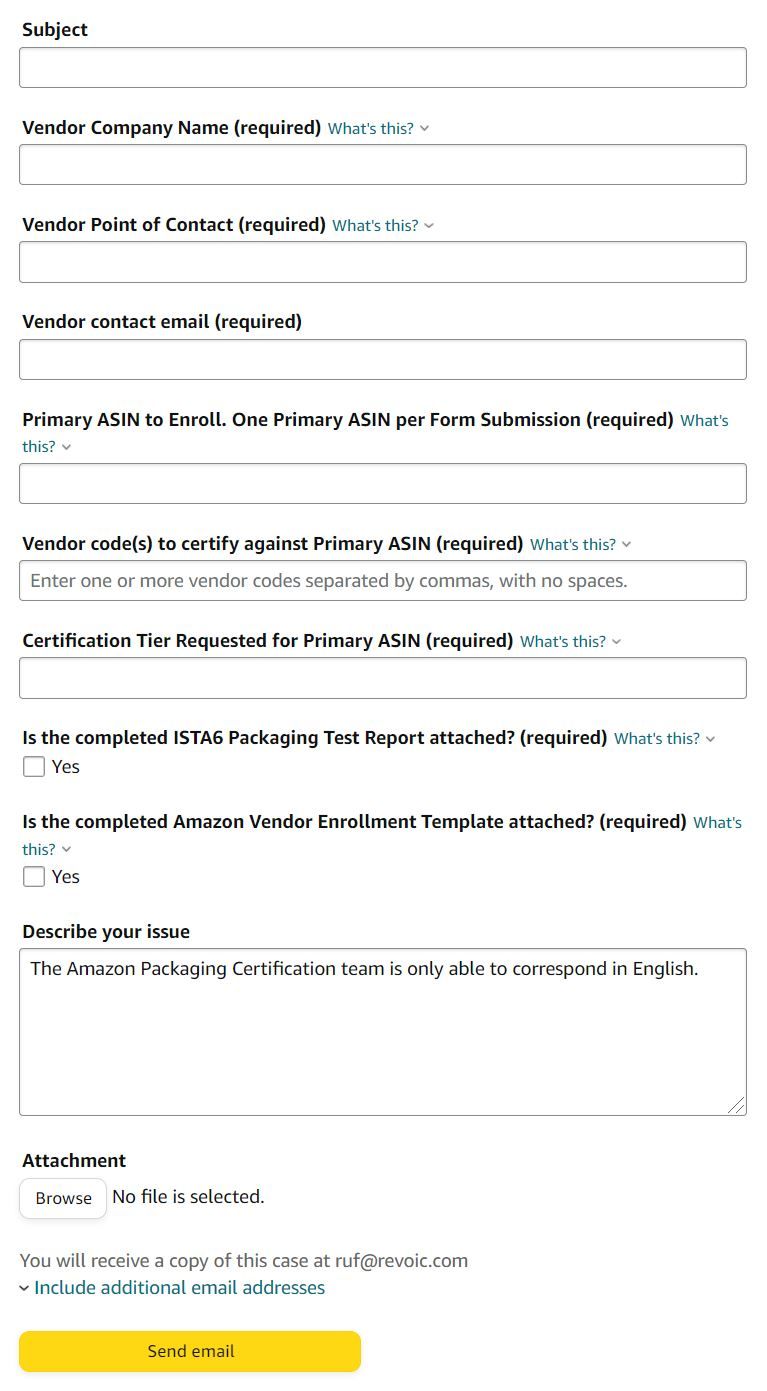
You can find the ASIN registration here → under "Amazon Vendor enrollment template". Do not confuse this document with the document "Vendor enrollment template (Amazon Packaging Lab)", which you need for the Amazon Packaging Lab.
In the Excel document, you will see the "Enrollment Template" on the one hand, and an example to fill in on the other hand.:

The Enrollment Form is similar to the Vendor registration form for Amazon's Packaging Lab from the previous section. Again, you can change the language so that the help pages behind the "Click Here" links are displayed in your preferred language. The explanations for columns A, B, C, D, and E are identical to those from the previous section
- Column A: the ASIN is a 10-digit alphanumeric number that Amazon uses to identify the product to be certified
- Column B: the vendor code is usually 32 characters. You will find this on the order of the product to be registered
- Column C: under Region, you can choose between "EU" (European Union) and "NA" (North America). If you sell your product on both marketplaces, then select "Both"
- Column D: here you have a dropdown menu again. In the first row, you need to select "Primary ASIN". The primary ASIN is the item you are sending to the packaging lab for testing. There can only be one primary ASIN per registration. For all other lines, you have the options "Same Primary ASIN - Alternative Vendor Code" (this is a product with the same ASIN but not yet certified), "Secondary ASIN - Color, Flavor, Scent, or Formula Variation" (the product differs from the primary ASIN only in terms of color, flavor, scent, or formula), and "Secondary ASIN - Form-Factor Variation" (the product differs from the primary ASIN only in terms of packaging). The options indicate how the secondary ASINs relate to the primary ASIN. If you are unsure which option to select, view the Help Video from Amazon. This document explains the certification rules for secondary ASINS
- Column E: here you specify the type of certification you are requesting. You choose between FFP, SIOC, and PFP
- Column F: for this column, you specify the laboratory that certified your ASIN. The entry is "Amazon" if the primary ASIN is already certified and you want to certify secondary ASINs additionally. If you performed the test yourself, indicate "Self" in this column
- Column G: in the "Future Certification Date" column, Vendors can tell Amazon the earliest date that their new packaging certification, if approved by Amazon, should be effective. This allows Vendors to tell Amazon when they expect their inventory to be ready for shipment with the new packaging in the Amazon logistics center. If you leave this field blank, the date of certification by Amazon will be automatically inserted
Note that, again, a separate Amazon Vendor Enrollment Template must be submitted for each registered ASIN. Secondary ASINs submitted for collective certification, also called cluster certification, together with a primary ASIN may be submitted via the same registration form.
As a customer, how can I tell if my package is certified?
As a customer, it's not to see whether a product you've ordered has FFP, SIOC, or PFP certification. Amazon does not mark this and also does not differentiate between the three certification levels.
However, you can recognize a product with a SIOC or FFP certification by the fact that the item arrives at your door without an Amazon outer box. A PFP product, however, will arrive at your door in an Amazon outer box, just like any uncertified package.
Here are a few examples of how Amazon marks certification:
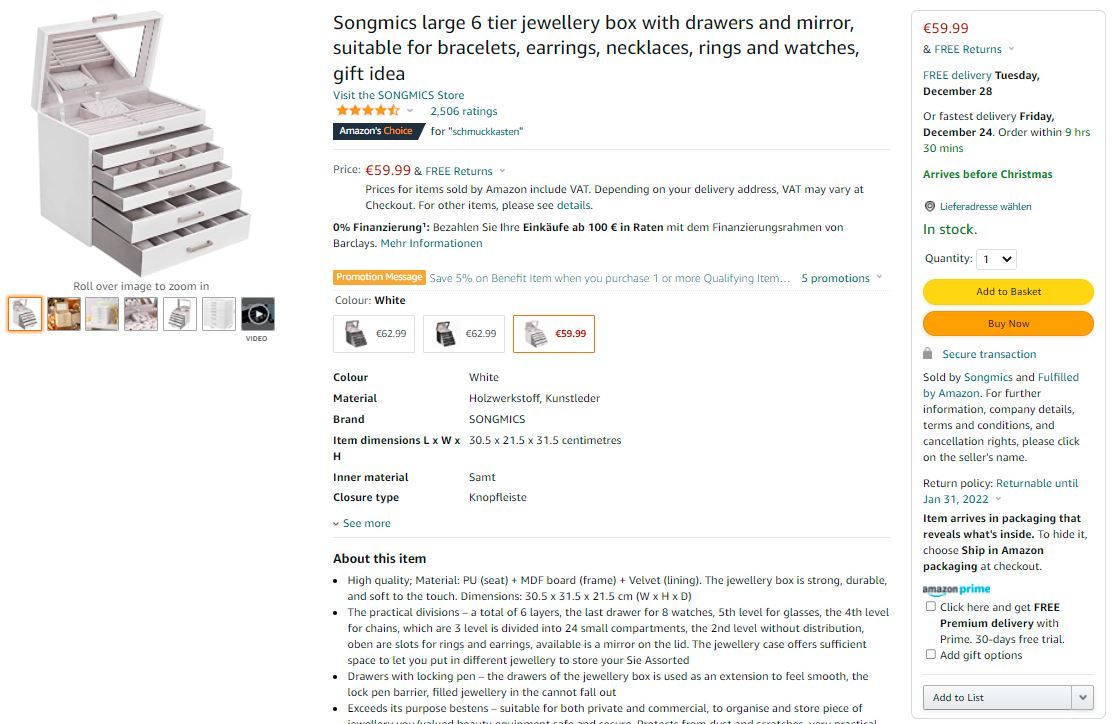
For this item it says on the right under the delivery information "Item arrives in packaging that reveals what's inside". This tells you that the item is certified for the "Frustration-Free Packaging" program. If you would still like the item to be additionally packed by Amazon in an outer carton, you can specify this afterward during the purchase process.
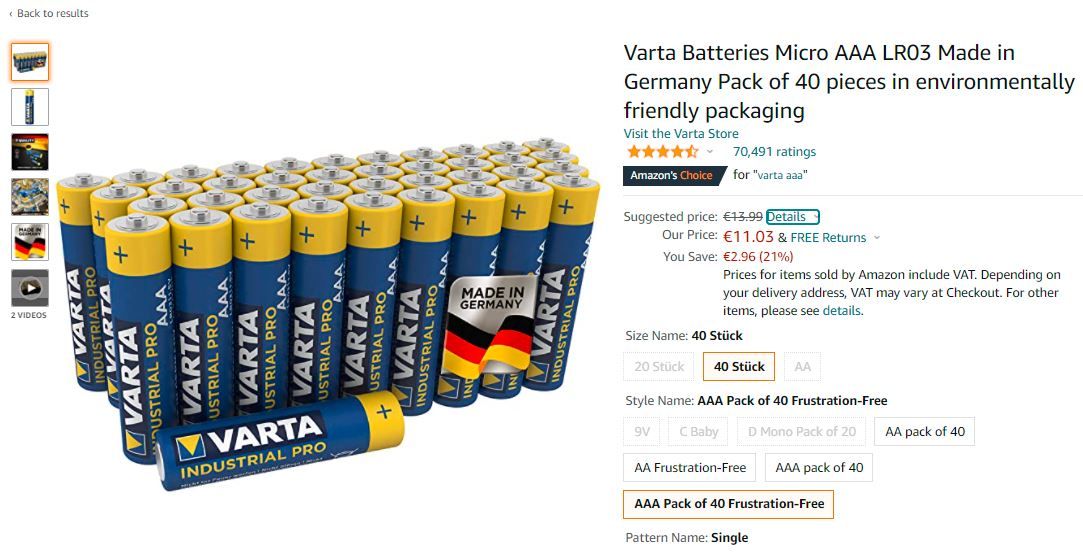
For this item, you can select how the item should be shipped under "Style". Choose "AA Frustration-Free", then the items will arrive at you without any additional Amazon box.
Conclusion
Any Vendor shipping products larger than 45.4 cm x 34.0 cm x 26.5 cm, heavier than 12.3 kg, and not covered by the exemptions must comply with Amazon's specified testing methods or certification procedures and have the products certified. Shipping packages, if they contain liquids, fragile items, TVs, monitors, or weigh more than 22.7 kg, must be certified by Amazon and tested by an ISTA-certified testing laboratory. Packages that do not contain liquids, fragile items, or weigh less than 23 kg can be tested by the Vendor itself. Likewise, if the items are fragile but weigh less than 23 kg, Vendors recently have the option to send their items to an Amazon packaging lab for testing and enrolling.
If you do not have your products certified, or if they have only received Level 3 "Prep-Free Packaging" certification, you will continue to incur chargeback payments of €1.70 per ASIN.
Keep in mind that you will need to design packaging differently for online shipping than for retail. The multitude of regulations makes it seem impossible to create appropriate shipping packaging for some products, but that's the only way you'll avoid chargeback payments.
Third-party certification costs between $1,000 and $1,600 on average. If you have the option to self-test or send your items to the Amazon packaging lab, then you should take advantage of the options. In some cases, you have to calculate whether certification is worth it. If only a few items are sent to Amazon, it may be cheaper to pay the chargeback. You also need to include in the calculation the higher cost of the new shipping packaging.
List of links to relevant pages / documents:
- Amazon Help Page on Shipping Package Testing and Certification
- Certification guidelines for the FFP program
- Amazon help page for the Vendors self-test
- Amazon Drop test evaluation form to carry out the Vendor self-tests
- Example of a completed drop test evaluation form
- Amazon Help page for Amazon packaging lab
- Amazon Vendors enrollment template. If you are self-testing or a third-party vendor is testing your products, select the first document "Amazon Vendor enrollment template". Select "Vendor enrollment template (Amazon Packaging Lab)" if you are sending your packaging to Amazon Packaging Lab for testing.
- Help video to fill in the column correctly "ASIN Type" in the Vendors registration form.
- ISTA-Website to find a third-party test lab. Alternatively, you can find here → a list of the APASS network
